Watercress: The Forgotten Superfood with Multiple Benefits
In a hurry? Click here to read the Article Summary...
“There was a table set out under a tree in front of the house, and the March Hare and the Hatter were having tea at it…. Oh, surely, surely there were watercress sandwiches! What’s a tea without them?”
~ Alice in Wonderland, Lewis Caroll
Once upon a time, watercress was more than just that green garnish left on the side of your plate. Indeed, watercress was a much loved cruciferous consumed by many, as far back as Roman times. Even old Hippocrates is said to have given his patients watercress [1]. And, as evidenced by the above quote from Alice in Wonderland, a watercress sandwich used to be a delight and necessity for any proper English afternoon tea.
Perhaps it is because it is so easy and fast to grow this water-cultivated vegetable that watercress became known as a “poor man’s food” and went out of fashion. Whatever the reason, it is a shame that this nutrient packed food was relegated to mere decoration.
Happily, more and more people are discovering that watercress is one of the best-kept secrets of the “superfoods” revolution and offers a host of health benefits.
Watercress Gets Top Marks as a Superfood
 While you’ll often hear the term “superfood” bandied about everywhere these days, in this case it’s true – watercress is absolutely brimming with nutrients and phytochemicals.
While you’ll often hear the term “superfood” bandied about everywhere these days, in this case it’s true – watercress is absolutely brimming with nutrients and phytochemicals.
Perhaps you’ve heard of the ANDI Food Scores? It stands for the Aggregate Nutrient Density Index.
This index evaluates the number and measure of nutrients in a food – minerals, vitamins, carbohydrates, proteins and fats – relative to the amount of calories it contains. The Index gives foods a score out of a possible 1000. The higher the number, the more nutritious the food is considered to be.
Then there’s the CDC’s (Center for Disease Control) Nutrient Density list. This system scores foods out of a possible 100, with top marks given to those “most strongly associated with reduced chronic disease risk [2].”
Watercress gets top marks on both lists, being the only vegetable on the CDC’s list to get a full 100 points [2], while also appearing at the very top of the ANDI, being only one of four items to score a full 1000 [3].
Just to give you an idea of the nutritional benefits of this member of the brassica family, watercress contains more calcium than a glass of milk, more vitamin C than you’ll find in an orange, and more iron than spinach [4,5].
Not only that, watercress is considered a superior organic source of vitamins A, B1, B6, C, of beta-carotene, magnesium, lutein, and zeaxanthin [6].
Especially of note, watercress is one of the only vegetables that contain high quantities of vitamin K. Just one cup of these greens will give you more than the minimum daily recommended amount of vitamin K [4,7].
In fact, watercress contains more than 15 essential vitamins and minerals [5], and all the powerhouse benefits of cruciferous veggies, including the two glucosinolates, sulforaphane and gluconasturtiin (a precursor to the ITC phenethyl isothiocyanate [aka PEITC]) [8].
Bioactive Compounds of Watercress Benefit Your Health
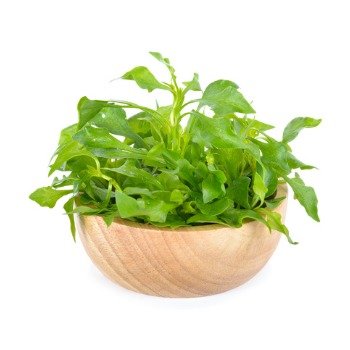 Of all the many nutrients and bioactive compounds found in watercress, the following are of special note when it comes to supporting good health:
Of all the many nutrients and bioactive compounds found in watercress, the following are of special note when it comes to supporting good health:
Glucosinolates:
When looking at the individual phytochemicals of watercress, it makes sense to start with the superfood phenomenon – glucosinolates.
Watercress contains a whopping 32 grams of glucosinolates, per cup [4]. That matters because there are two glucosinolates that have garnered extra attention in the world of health research due to their compounding effects on wellness: sulforaphane and gluconasturtiin.
- Gluconasturtiin: This phytochemical is a precursor to the ITC phenethyl isothiocyanate (PEITC), and watercress contains more of it than any other brassica (cruciferous) vegetable. This is important because it’s a compound that is being studied extensively by researchers for its potential effects on human health [9-11].
- Sulforaphane: This phytochemical is formed when damage occurs to the plant, usually by chewing. Sulforaphane is under even closer scrutiny for its wide range of promising effects on health.
Lutein and Zeaxanthin:
Watercress is a good source of lutein and zeaxanthin. According to the American Optometric Association, deficiencies in these carotenoids have been linked to AMD (advanced age-related macular degeneration) which is the primary cause of blindness for those aged 55 and up [12].
Chlorophyll:
Chlorophyll, as you may recall from biology class, is what makes plants green, and helps them convert sunlight to food. For humans, consuming plants dense with chlorophyll is widely accepted as providing an array of health-promoting benefits.
Vitamin C:
Vitamin C is an important antioxidant that your body requires for tissue repair (including brain repair), making collagen (important for the skin, tendons, cartilage, etc.), as well as both maintaining and repairing bones and teeth.
According to the University of Maryland Medical Center, deficiencies in vitamin C are associated with a number of health ailments, including “high blood pressure, gallbladder disease, stroke, some cancers, and atherosclerosis, the buildup of plaque in blood vessels that can lead to heart attack and stroke [13].”
Vitamin C is a water-soluble vitamin that is excreted through urine. This means your body does not store it, and you need a regular supply.
Watercress is high in bioavailable vitamin C, ensuring you get slightly under 50% of the recommended daily amount in just two cups of the superfood.
The National Health Institute (NHI) has this to say on its vitamin C fact sheet [14]:
“Vitamin C is required for the biosynthesis of collagen, L-carnitine, and certain neurotransmitters; vitamin C is also involved in protein metabolism. Collagen is an essential component of connective tissue, which plays a vital role in wound healing. Vitamin C is also an important physiological antioxidant and has been shown to regenerate other antioxidants within the body, including alpha-tocopherol (vitamin E).
Ongoing research is examining whether vitamin C, by limiting the damaging effects of free radicals through its antioxidant activity, might help prevent or delay the development of certain cancers, cardiovascular disease, and other diseases in which oxidative stress plays a causal role.
In addition to its biosynthetic and antioxidant functions, vitamin C plays an important role in immune function and improves the absorption of nonheme iron, the form of iron present in plant-based foods. Insufficient vitamin C intake causes scurvy, which is characterized by fatigue or lassitude, widespread connective tissue weakness, and capillary fragility.”

Folate:
Watercress contains natural, bioavailable amounts of this B vitamin (known as folic acid in its synthetic form). Another water-soluble vitamin, your body requires regular doses in order to be healthy. Folate assists cellular function and is a well-known nutrient needed in pregnancy [15].
Calcium:
Getting your required calcium from plant sources has many benefits [16,17]. Not only is calcium required for bone health but also, per the National Health Institute’s fact sheet, for: “vascular contraction and vasodilation, muscle function, nerve transmission, intracellular signaling, and hormonal secretion.”
The NHI also has this to say about deficiency (hypocalcemia):
“Symptoms of hypocalcemia [calcium deficiency] include numbness and tingling in the fingers, muscle cramps, convulsions, lethargy, poor appetite, and abnormal heart rhythms.
If left untreated, calcium deficiency leads to death. Over the long term, inadequate calcium intake causes osteopenia which if untreated can lead to osteoporosis [17].”
Vitamin K:
As previously mentioned, watercress contains high amounts of bioavailable vitamin K, which is a rarity in the plant world. This water-soluble vitamin is named after the first recognized biological role it plays in your body – clot formation (the “K” coming from the German word, koagulation) [19].
Getting the Benefits of Watercress from Your Diet
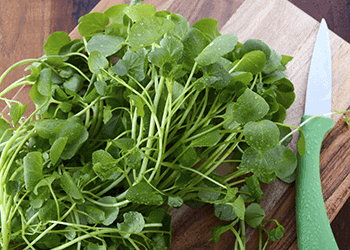 Eating a balanced diet includes consuming an array of fresh fruits and vegetables in order to receive the maximum vitamins and nutrients available from the plant world.
Eating a balanced diet includes consuming an array of fresh fruits and vegetables in order to receive the maximum vitamins and nutrients available from the plant world.
In the case of how to get more watercress in your life: Add a cup to your salad or smoothie. Add it to your soup just as you serve it, so it doesn’t lose all its nutritional value with cooking. Perhaps take a leaf out of Alice in Wonderland and have a watercress sandwich.
In off-season times, or even just for convenience and ensuring you’re getting the full impact of all the best properties of this superfood plant, you may consider a supplement version of watercress.
When choosing a product, keep an eye out for quality and the widest range of absorbable nutrients for optimal health-supporting benefits.
The latest formula of Organic OrganiGreens is our best yet. In just one simple scoop, add 17 sprouted and fermented superfoods and botanicals, plus probiotics and enzymes, to your daily diet to fill nutritional gaps and support healthy immune function, increased energy and mental clarity, as well as digestion and detoxification processes. Easily mixes in water, smoothies, juices, and recipes, and it also tastes great – even without any added sugars.
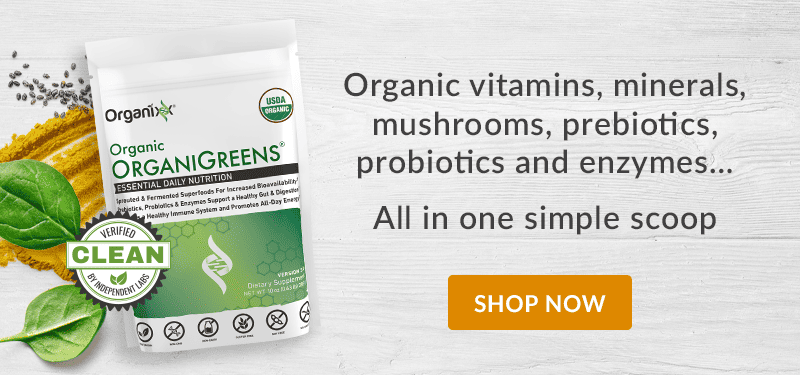
 Sources:
Sources:
Article Summary
Watercress is one of the best-kept secrets of the “superfoods” revolution and offers a host of health benefits.
Watercress is absolutely brimming with nutrients and phytochemicals.
Watercress is one of the only vegetables that contains high quantities of vitamin K.
Watercress contains more calcium than a glass of milk, more vitamin C than you’ll find in an orange, and more iron than spinach.
In the case of how to get more watercress in your life: add a cup to your salad or smoothie or add it to soup just as you serve it.
In off-season times, or even just for convenience and to ensure you’re getting the full impact of this superfood plant’s best properties, you may consider a supplement that includes watercress.

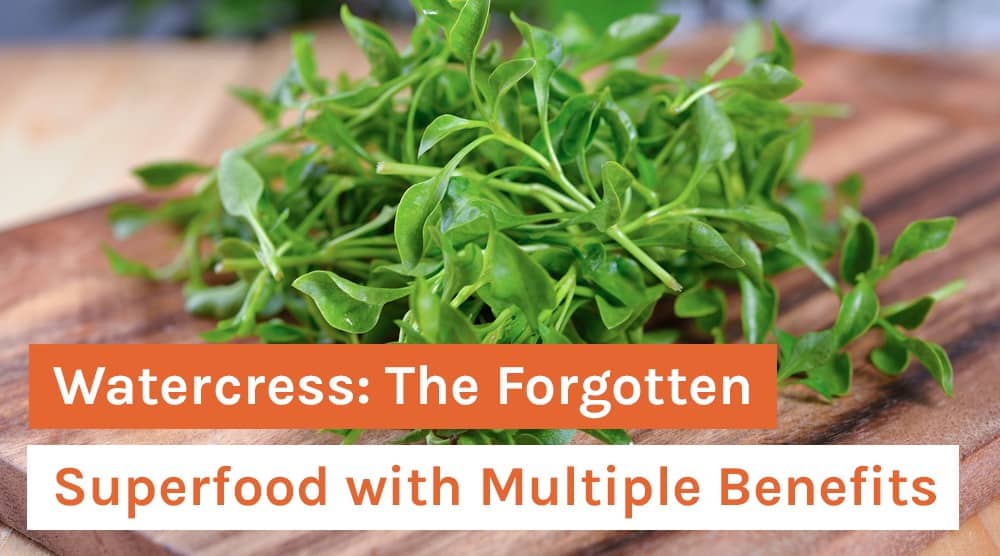
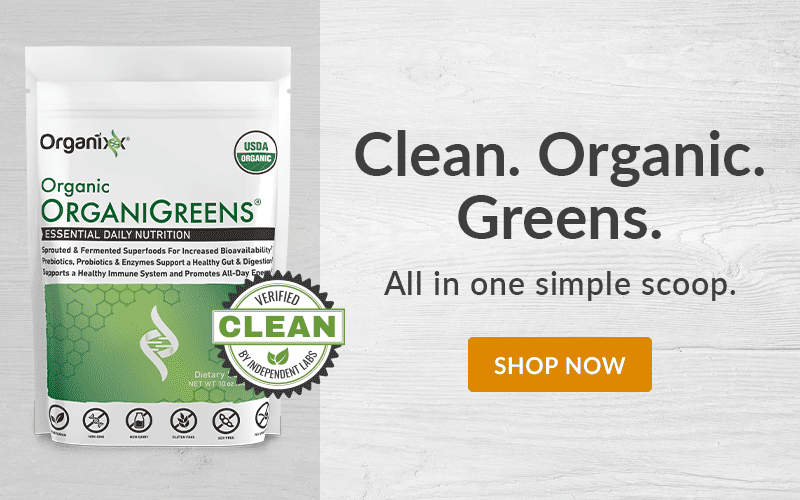
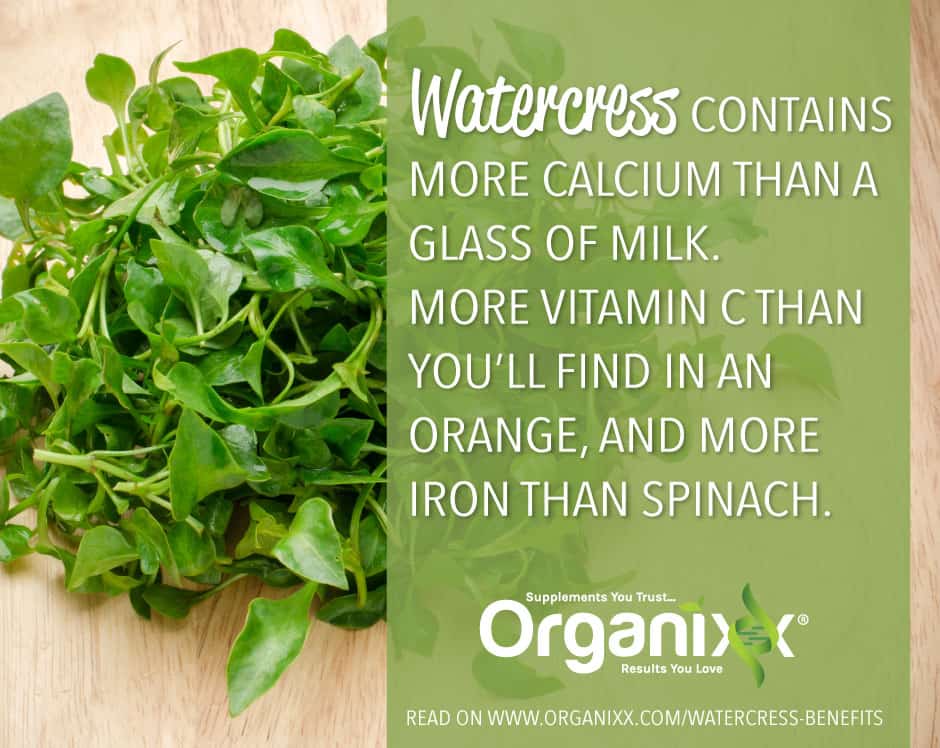
Maureen:
Wish you'd get off the "Big Pharma" prescriptions for blood thinner et al and fill your fridge with all greens. Plus, if you supplement with a high quality Krill Oil ( I like Mercola's), it acts as a natural blood thinner.
Also if you steam fresh beets, don't throw away those beet greens because they are one of the healthier greens. I suggest sauteed with garlic, not raw.
I think Hippocrates said it best...Heal Thyself... I believe he did so with herbs and plants.
Best,
Scorpio rosso
If it's that high in Vit K, anyone on a blood thinner had better be careful with it.
They may be able to replace the blood thinner drugs for the natural watercress, or at least be able to reduce any drug taking. My sister was on warfarin, started taking ginkgo biloba and eventually was taken off the drug. Work with your doctor and let him know that you want to try another way and with blood tests can monitor the progress... just my thoughts
This is good information and I would like to try it in my smoothies drinks or in soups
As far as I know Vitamin K îs liposoluble!!!
Thank you for this valueable information. Hope I ll find the right kind in Malta.We do find some imported cress already packed in our supermarkets.